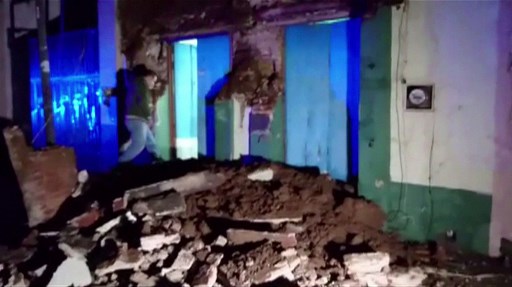
MEXICO City, Mexico (AFP) — At least 15 people were killed in a powerful 8.2-magnitude earthquake in Mexico, an official said Friday, as 10 more bodies were found in the southern city of Juchitan.
“The death toll is 15 in all… based on the figures from each state,” the head of the disaster management agency, Ricardo de la Cruz, told TV station Milenio after the quake, the most powerful to hit Mexico in a century.
Officials evacuated residents along the central and southern Pacific coast as seismologists warned a tsunami of more than three meters (10 feet) could be headed toward land, affecting coastal towns as far south as Ecuador.
The quake hit offshore in the Pacific at 11:49 pm (0449 GMT), about 100 kilometers (60 miles) from the coastal town of Tonala, in far southern Chiapas state, Mexico’s seismologic service said, giving an updated magnitude of 8.2.
“It was a major earthquake in scale and magnitude, the strongest in the past 100 years,” said President Enrique Pena Nieto in an address from the National Disaster Prevention Center’s headquarters, where he was supervising the emergency response.
The US Geological Survey put the magnitude slightly lower, at 8.1. That is the same as a devastating 1985 earthquake that killed more than 10,000 people in Mexico City — the country’s most destructive ever.
Pena Nieto said three people were killed in collapsing buildings in Chiapas.
In neighboring Tabasco state, two children were killed, the governor said.
One was crushed by a collapsing wall. The other, an infant on a respirator, died after the quake triggered a power outage.
A hotel collapsed and several houses were damaged in Juchitan, in the state of Oaxaca, but no fatalities were reported there.
The president downplayed the tsunami threat, saying it was “not a major risk at this time.”
But coastal communities were on alert across a warning area that stretched through the Central American countries of Guatemala, El Salvador, Costa Rica, Nicaragua, Panama and Honduras, all the way down to Ecuador.
“Based on all available data … widespread hazardous tsunami waves are forecast for some coasts,” the Pacific Tsunami Warning Center said.
“Tsunami waves reaching more than three meters above the tide level are possible along the coasts of Mexico,” it said, with lower waves in other countries.
Tsunami waves of up to one meter could also reach New Zealand, according to seismologists in Australia.
– ‘The car was wobbling’ –
Pena Nieto said 50 million of Mexico’s 120 million people felt the quake.
It shook a large swath of the country and was felt as far north as Mexico City — some 800 kilometers from the epicenter — where people ran from their homes as buildings trembled and swayed.
It was also felt in much of Guatemala, which borders Chiapas.
Mexican officials ordered schools to remain closed Friday in 11 states, including Mexico City, so officials could inspect for structural damage.
In the capital, people ran out of buildings — many in their pajamas — after hearing earthquake warning sirens go off just before midnight (0500 GMT Friday).
“I was driving when the ground started to shake. The car was wobbling,” said Cristian Rodriguez, a 28-year-old Uber driver in Mexico City.
“We heard an explosion. Apparently it was a transformer. The streetlights started swinging back and forth,” said Mayaro Ortega, 31, a resident of the capital’s north side who went running from her building.
The quake struck at a depth of 69.7 kilometers, according to the USGS.
Since the 1985 earthquake, Mexican authorities have instituted a stricter building code and developed an alert system using sensors placed on the coasts.
Mexico sits atop five tectonic plates, whose movement makes it one of the most seismically active countries in the world.
(by Sofia MISELEM / Joshua Howat BERGER, Agence France-Presse)







